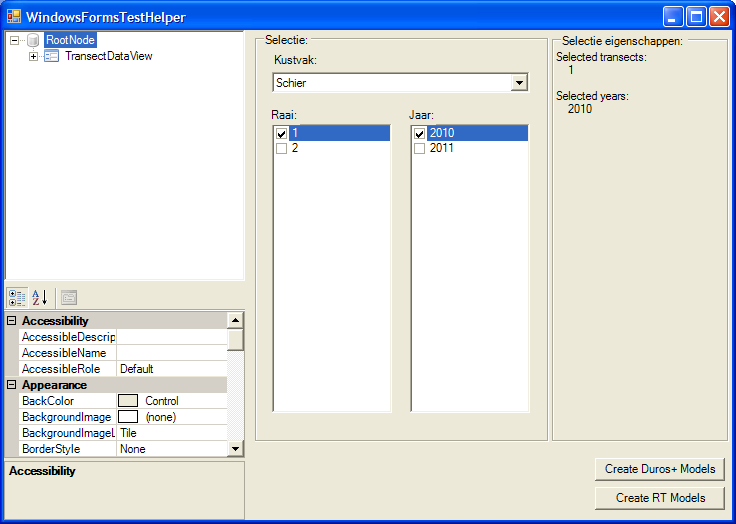A bit ugly but we can write integration tests involving Windows.Forms controls
[Test]
[NUnit.Framework.Category("Windows.Forms")]
public void CreateAndShowTransectDataView()
{
var app = mocks.Stub<IApplication>();
var gui = mocks.Stub<IGui>();
var project = new Project();
app.Project = project;
gui.Application = app;
var provider = new DurosPlusModelViewProvider {Gui = gui};
var transectData = DurosPlusModelMockHelper.CreateSampleTransectData();
project.RootFolder.Add(transectData); // <-- project must contain TransectData in order to create DurosPlus model
var view = (Control)provider.CreateView(typeof (TransectDataView), transectData);
// show a message box when item is added to the project
project.RootFolder.CollectionChanged += delegate(object sender, NotifyCollectionChangedEventArgs e)
{
log.DebugFormat("New item has been added: {0}", e.Item);
// assert
e.Item.Should("check if newly added item is Duros+ model").Be.OfType<DurosPlusModel>();
};
// select 2 checkboxes and click on a "Create Duros+ Models" button.
var groupBoxSelection = (GroupBox)view.Controls["groupBoxSelection"];
var checkedListBoxTransect = (CheckedListBox)groupBoxSelection.Controls["checkedListBoxTransect"];
var checkedListBoxYear = (CheckedListBox)groupBoxSelection.Controls["checkedListBoxYear"];
var buttonCreateDurosPlusModels = (Button)view.Controls["buttonCreateDurosPlusModels"];
// do something after form is displayed
Action<Form> formShownAction = delegate
{
checkedListBoxTransect.SetItemChecked(0, true);
checkedListBoxYear.SetItemChecked(0, true);
buttonCreateDurosPlusModels.PerformClick();
};
WindowsFormsTestHelper.ShowModal(view, formShownAction);
}
After test runs:
- 2 checkboxes are checked
- button is clicked
- model is created and added to the project
- assert checks if added item is of a proper type
Some tips on how to use it:
- Make sure to name all controls on the form correctly
- Use Document Outline in Visual Studio to check names of controls, make sure names are readable and intuitive!
Probably we should refactor WindowsFormsTestHelper a little to make it more usable. Add any ideas as comments to the current blog post.


1 Comment
Unknown User (berg_p)
You can easily test the behavior of the form by sending keystrokes to it using the SendKeys class
public void ShowNonInterpolatedFunctioAndAddNewValue() { IFunction function = new Function(); var x = new Variable("x"); var y = new Variable("y"); function.Arguments.Add(x); function.Components.Add(y); function[3] = 20; function[4] = 30; function[5] = 50; x.InterpolationType = ApproximationType.None; var functionView = new FunctionView { Data = function }; Action onShown = delegate { Assert.AreEqual(new[] { 3, 4, 5 }, x.Values); // Set focus to table and 4th row SendKeys.SendWait("{TAB}{TAB}{TAB}{TAB}{TAB}{DOWN}{DOWN}{DOWN}"); // enter a new value to the table SendKeys.SendWait("9"); }; WindowsFormsTestHelper.ShowModal(functionView, onShown); Assert.AreEqual(new[] { 3, 4, 5, 9}, x.Values); }